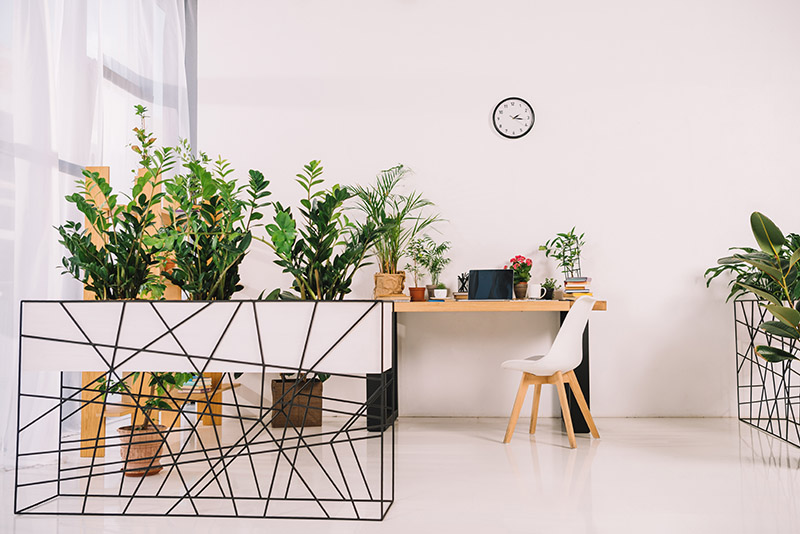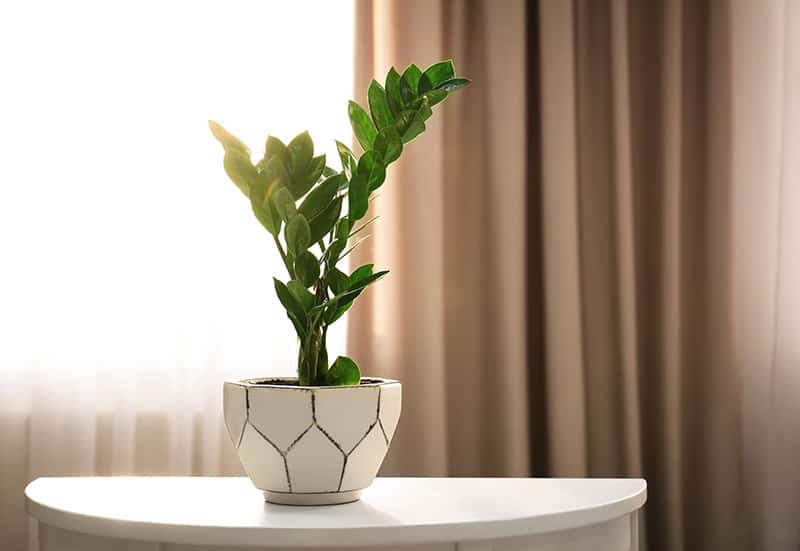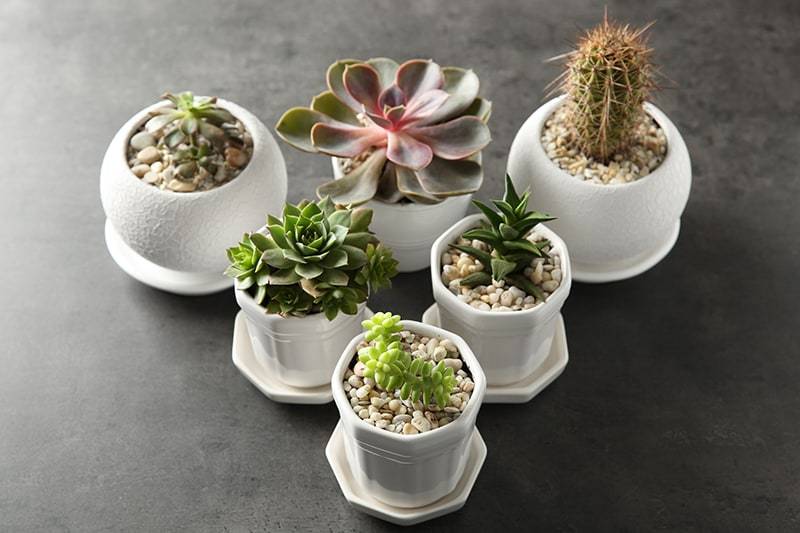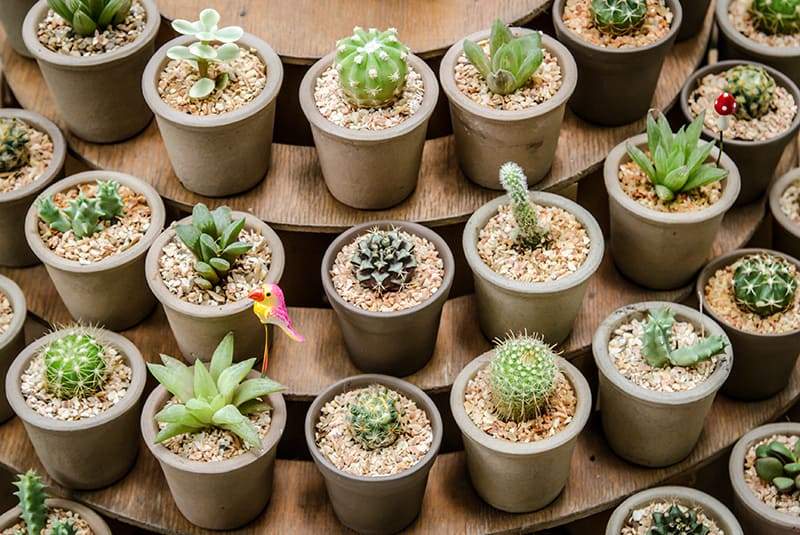CFLs are no doubt among the most popular light types used in the last 20 y... Read More
- Home >
- 10 Best Office Plants – The Definitive Guide
10 Best Office Plants – The Definitive Guide

Houseplants have so many benefits to our health, including physically, emotionally, and mentally. They can improve your mood, boost productivity, reduce stress, and remove toxins from the air. With all of this in mind, it seems only logical that the office would be an ideal place to grow some indoor plants, as this is where many people spend the majority of their time.
Given that you probably aren’t going to have the time to continually tend to a plant’s needs while at work, the best plants for an office will be low maintenance. You’ll also need to find a plant that is happy to grow in your office environment. Some plants require plentiful sun, while others thrive in the shade, and it’s important to do a little research to make sure you’re choosing the right plant for your lighting levels to prevent your desk from becoming a plant morgue.
Follow our guide below to find out the best office plant for your situation.
Benefits of Office Plants
Productivity Boost
If you’re feeling a little deflated at work or struggling to make a breakthrough in your career, a plant might be a good option to try. Studies from the University of Exerter have shown that indoor plants boost concentration and productivity by as much as 15%. If you’re a manager wanting to improve the efficiency and work output of your staff, simply decorate your office with a series of indoor plants and watch your business thrive.
Improve Mood
Indoor plants increase positivity and have a positive impact on our mood. They have been shown to reduce loneliness and depression and help us feel soothed and more relaxed. One of the ways they do this is by regulating humidity levels of the air around us. If your office feels drab and depressing, introducing indoor plants will help to boost the mood and morale of your team, typically resulting in a more productive environment that is conducive to success.
Remove Toxins
A 1989 study by NASA, dubbed the ‘Clean Air Study,’ found that certain plants play a key role in filtering toxins from our air. Synthetic materials found in everyday life produce harmful chemicals that infiltrate our air. These chemicals, or toxins, are also known as volatile organic compounds, and they are known to be irritants and potential carcinogens, potentially making people fall ill if air circulation is poor.
Toxins typically polluting our air are trichloroethylene, formaldehyde, ammonia, xylene, and benzene. NASA’s study found that some plants have the ability to absorb these toxins and simultaneously give out cleaner oxygen, filtering our air from harmful chemicals and making it a safer space to exist in. The details of the study showed that some plants had the ability to reduce toxins in the air by up to 87% in just 24 hours. This effect of indoor plants could make colleagues or staff in your office healthier, and potentially even result in less time taken off work for sick days.
Stylish Design
Indoor plants have seen a rise in popularity over the last few years, and this trend to accessorize your interior with plants is only set to continue. Plants can act as art in some settings, giving people a visual focus or something interesting to look at. For many people, the visual aesthetics of plants simply bring joy. Decorating your office space with plants could help you feel more at home when sat at your desk, and having a stylish workspace filled with plants may make your office a more enjoyable place to work, lifting the spirits of those around you.
The Winners
1. Best for Filtering Air: Hedera helix (English Ivy)

Ivy is well known as an easy growing plant commonly found outdoors, but it also makes an excellent indoor plant. English Ivy is one of the best plants on the planet at filtering the air, as it removes all five of the most commonly found toxins in our indoor environments: formaldehyde, xylene, benzene, ammonia, and trichloroethane (by comparison, most other plants which are good at filtering air typically only remove one or two different toxins).
English Ivy also fits the criteria of being a good office plant because it is low maintenance. It likes to be watered once the top of the soil is dry to the touch and isn’t too fussy about humidity or temperature. It will grow well in most conditions, but one thing it won’t do well in is shade. If your office is particularly dim or doesn’t receive much natural sunlight, then this is not the plant for you. While the Ivy might still survive for a while in low light, it will become spindly and unattractive, and its leaves will begin to drop. Variegated Ivy will lose its contrasting colors if not allowed enough light.
Key Care Requirements
Water: Moderate
Light:Bright, indirect light
2. Best for Low Maintenance: Zamioculcas Zamiifolia (ZZ Plant)
This plant is the ultimate in low maintenance. It is ideal for offices where it might find itself the victim of neglect, or for forgetful owners who miss a watering (or three!). It is drought tolerant, hailing natively from the dry plains of Africa, and it is not fussy about the light it receives, being able to happily thrive in both bright light, low light, and shade. It will be happy in any type of soil, as long as it drains well, and it is able to cope with a range of temperatures.
The ZZ Plant is also good at filtering the air, working tirelessly to provide you with cleaner air while you do very little in the way of maintaining it. This plant grows slowly, reaching maturity at around two feet tall. This works perfectly in an office environment as it means you rarely, if ever, have to prune it because it does not become large or out of control. Its slow growth also means it can live for a long time in the same pot, requiring infrequent repotting. It only needs to be watered occasionally, and in fact, the worst thing you could do to this plant is overwater it.
Like most houseplants, it is susceptible to root rot, which is caused by too much moisture in the soil. Avoid this by never allowing the ZZ Plant to sit in soggy soil, and only water it once the soil has dried out to prevent it from being watered too frequently. It can thrive in dry soil for a considerable amount of time due to its rhizomes under the soil. These are bulbous roots which resemble onions, and they store water, which the plant can live off if it does not have any moisture in its soil.
As well as being an easy-care plant that is almost impossible to kill, the ZZ Plant is very attractive and will brighten up and dull or drab office space. The one drawback of this plant is that all parts of it are poisonous, though this shouldn’t be a problem so long as any of your co-workers are not babies or pets.
Key Care Requirements
Water: Water sparingly. Do not over water.
Light:Any
3. Best for Low Light: Epipremnum aureum (Pothos)
Renowned as being the plant that’s impossible to kill, this plant is ideal for offices or anyone who is just starting out at learning to care for plants. It famously does well in low-light conditions and has even been known to continue growing in almost total darkness. It can happily grow in the shade and does not even require sunlight to thrive, doing just fine in fluorescent lighting.
As well as being ideally suited to dim or artificially lit offices, the Pothos is also an undemanding plant in several other ways. It does not need to be fed fertilizer and will grow at quite an impressive rate without any nutrients added to its soil. It will thrive in both nutrient-rich or poor soil. It is drought tolerant and can cope well with sporadic waterings. While it prefers a humid environment, it will grow just fine in dry air.
It is drought tolerant and will survive lengthy periods without water. On top of these easy-care attributes, the Pothos plant is also very attractive to look at, with its variegated glossy foliage. It also ranks highly among NASA’s list of best plants for filtering air pollution.
Key Care Requirements
Water: Allow soil to dry between waterings, will tolerate sporadic or infrequent waterings
Light:Low light
4. Best for Direct Sun: Succulents
If you are lucky enough to have an office bathed in natural sunlight, then succulents will be your best friend. Unlike many houseplants that will scorch or dry out in direct sunlight, succulents grow happily on bright windowsills or light and warm environments, making them ideal for south-facing windows or rooms that are exposed to a lot of sunlight such as conservatories, sunrooms, or offices built predominantly of glass. Succulents also work well as office plants because of their low maintenance requirements.
They generally require small amounts of water infrequently, do not need to be pruned, and do not grow rapidly. They typically thrive in dry air, with their only needs being a warm and bright position. As long as you can meet these needs, you should find succulents an undemanding plant to grow. If you’d like a succulent for your desk, try the Aloe Vera Plant, or the Jade Plant. Both of these store moisture in their leaves, therefore only need to be watered very sparingly. Don’t be tempted to frequently water your succulents; this is the most common reason for the loss of a succulent.
Key Care Requirements
Water: Water sparingly
Light:Bright light
5. Best All-Rounder: Sansevieria (Snake Plant)
The Snake Plant, also commonly called ‘Mother-in-Laws Tongue,’ is an incredibly versatile and almost indestructible indoor plant. It thrives on neglect, so an office environment works perfectly for it. It has a bold, upright, architectural look that will suit modern or minimalist office styles, and it cleans the air around it, filtering out formaldehyde and nitrogen oxide to give you healthier air at work.
In terms of care, this plant will grow best if you ignore it for the majority of the time. It doesn’t need to be watered often, around every two or three weeks during spring and summer, and only once or twice throughout the whole of fall and winter. It has rhizomes beneath the soil’s surface which store water, making it drought tolerant and able to go for extended periods without watering.
The Snake Plant isn’t fussy when it comes to temperature or humidity. It will do well in both dry, stale air, as well as highly humid environments. It can tolerate both low and high temperatures, including office atmospheres that typically have air conditioning in the summer and heating in the cooler months.
The Snake Plant can also survive in a series of lighting environments. It will do just as well in a shaded position as it will in a bright position. If you do place this plant in bright light, it needs to be indirect. One thing that this plant does not like is the direct sun; this will scorch the foliage and eventually lead to its demise.
The Snake Plant does not need to be fertilized, which is ideal for a low-maintenance office plant. It can be fertilized during summer if you wish, but it will do just fine without it. It is also happy in any type of soil, doing well in both nutrient dense soil as well as poor soil. The only requirement you need to set with the soil is that it drains well because overwatering is the most common cause of death for this plant. A well-draining soil will allow any excess moisture to filter out of the soil and prevent the plant from suffering from root rot, although you should also be taking care to not overwater this plant as another preventative measure against root rot.
This plant, in most cases, will last a long time. Fortunately, it does not need repotting very often and actually thrives while being root bound. In most cases, you shouldn’t need to repot this plant more than every five years, and could even go longer between repottings if you wish.
If you’re unsure which indoor plant to select for your office, the Snake Plant would be an excellent choice to meet a variety of needs; it looks good, it filters air, it is easy to care for, and is mostly unconcerned about the conditions in which it lives.
Key Care Requirements
Water: Water sparingly
Light:Any, except direct bright ligh
Other Ideal Office Plants
6. Dieffenbachia (Dumb Cane)
The Dumb Cane is so called because of its poisonous nature, which has the ability to strike you speechless if you are unfortunate enough to ingest any of the plant. For this reason, keep it away from any settings where children or pets may come into contact with it and always wear gloves if pruning or repotting the plant.
If you can get past the idea of having a poisonous plant on your desk, the Dumb Cane makes a great office plant. It has good air filtering properties and produces stunning variegated foliage. While it isn’t as indestructible as some of the other plants listed, it is fairly low maintenance and can tolerate a range of environments. It does not need to be watered too often and would prefer soil on the dry side of things rather than being too moist. It enjoys bright, indirect light, and high humidity, so feel free to give this plant an occasional water misting to keep it in top condition.
The Dumb Cane can adapt to a range of temperatures and does not need to be repotted frequently. It will make a good desk plant in a bright office.
Key Care Requirements
Water: Water Moderately
Light:Bright, indirect light
7. Apidistra (Cast Iron Plant)
This plant is commonly called the Cast Iron Plant because it is almost indestructible. It is ideal for an office environment because it can tolerate neglect and a wide range of environmental conditions. It grows very slowly, producing only a few new leaves each year. This is great news in terms of maintenance because it will take a long time to outgrow its container and need repotting. However, the slow-growing nature of this plant is what makes it more expensive to buy than many other houseplants. As it takes such a long time to reach a saleable size, it tends to have quite a high price tag attached to it, which might be a drawback when considering purchasing an office plant.
In terms of care, you won’t need to water this plant very often. It will grow well with sporadic waterings and prefers for the soil to go dry in between waterings. It copes well with poor air quality and dim lighting conditions, which is why it was a very popular houseplant in the Victorian era when the air was polluted and homes were dark and dank. This plant will grow happily in any office environment so long as it is not positioned in bright, direct light.
This plant only has two stipulations to ensure its survival: keep it out of direct sunlight and do not allow the soil to become wet or soggy. If you can meet these needs, the Cast Iron Plant is a solid choice of office plant.
Key Care Requirements
Water: Water sparingly
Light:Keep out of direct sunlight
8. Aglaonema (Chinese Evergreen)
This low-maintenance plant is perfect if you’re looking for patterned foliage for your office. There are several varieties available, which all have slightly different colors and patterns on their leaves, but fortunately, all are easy-care plants.
The Chinese Evergreen grows at a slow to medium rate, depending on its environment. Either way, it won’t become oversized very quickly and therefore, you won’t need to repot it or find an alternative space for it in a hurry. That being said, you can buy these plants in a range of sizes to suit any space in your office. Smaller plants will make good desk companions, while the more mature larger Chinese Evergreens look fabulous in hefty pots along corridors or in foyers.
These plants are well=known for tolerating low light, though ensure they do have access to some light; otherwise, the variegation on their leaves may suffer from fading. Their watering schedule will depend on their size, and the level of light and temperature of their environment, but you can typically expect to need to water this plant every one or two weeks during spring and summer, and then half as frequently during fall and winter. Use a well-draining soil to avoid overwatering and always check to see if the soil is dry to the touch before you add more water.
Though this plant is native to tropical and subtropical regions where humidity is high, the Chinese Evergreen has adapted well to more regular indoor air conditions and will do fine in environments with low humidity. Temperature-wise, this plant will be comfortable as long as you are comfortable. If possible, this plant will prefer to be kept away from any heating or air conditioning vents, which will dry it out.
Key Care Requirements
Water: Water moderately
Light:Low light to bright indirect light
9. Spathiphyllum (Peace Lily)
The Peace Lily is a good choice of the plant if you are fond of flowers. It has plenty of lush green foliage along with graceful white flowers. It works well in an office because it is suitable for both well-lit and poorly lit environments. Though it will thrive in either type of lighting, those plants allowed a higher percentage of light will produce more flowers than those in shaded areas.
The Peace Lily does not like to be watered too frequently and would much prefer to be sitting in dry soil than soggy soil. For this reason, only water your plant when it needs it, and not on a schedule. You can check to see if your Peace Lily needs water by dipping your finger into the soil. If it is moist, then leave it a few more days before checking again. Only proceed with watering once the top few inches of soil are dry to the touch. Some people wait until the leaves of the Peace Lily start to droop before watering it again, as this is an indicator that the plant wants more moisture. As the plant is drought tolerant, this won’t cause any damage to the Peace Lily and will prevent it from getting watered too frequently and suffering from root rot.
Key Care Requirements
Water: Water when soil is dry
Light:Medium to low light
10. Chlorophytum comosum (Spider Plant)
Spider Plants are easy to care for and are therefore often recommended as a beginner’s houseplant. Providing they have access to bright indirect light and receive enough water, they will thrive. Watering should only be carried out once the soil of a Spider Plant is dry to the touch. They dislike being in soggy soil and would prefer to be a little neglected over getting too much attention from the watering can.
They enjoy bright indirect light but will also do fine in partial shade, so long as they do have some access to sunlight. They are unconcerned with humidity levels and don’t necessarily need to be fertilized. They do well when root-bound, so they won’t need to be repotted very often at all, only when the roots have become very condensed. The Spider Plant does like temperatures a little cooler than most houseplants, so this might be a good choice for you if you work in an air-conditioned office.
One of the brilliant things about this plant is the baby ‘spiderettes’ it produces. These are miniature plants that dangle from the ends of leaves, usually during spring or summer. You can remove the spiderettes and plant them up in fresh soil, where they will grow into a brand new Spider Plant.
Key Care Requirements
Water: Water when soil is dry
Light:Bright, indirect light
Sources:
NASA Clean Air Study- Interior Landscape Plants for Indoor Air Pollution Abatement
Related Content
-
Best CFL Grow Lights – Grow Guide & Reviews
-
A Complete Guide to Aquaponic Gardening
In this article, you will learn about the basics of aquaponics practice - ... Read More
-
Coconut Coir – What It Is, Varieties, and How to Use It
The growing medium meets soil additive, coconut coir (or coco coir for sho... Read More
-
Top 15 Most Beautiful Flowers You Can Grow In Your Garden Immediately
"Flowers are the music of the ground. From earth's lips spoken without sou... Read More












